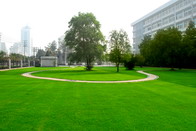| News |
| Events | |
| Int’l Cooperation News | |
| Upcoming Events |
 |
| Location: Home > News > Events |
| Effects and Potential of Water-saving Irrigation for Rice Production in China Revealed | TEXT SIZE:A A A |
Water-saving irrigation (WSI) is a promising management practice for sustainable rice production. Shallow-wet irrigation (SWI), controlled irrigation (CI), intermittent irrigation (II), and rain-gathering irrigation (RGI) are four common WSI regimes used in China. Researchers ZHUANG Yanhua, ZHANG Liang and LI Sisi from the Institute of Geodesy and Geophysics (IGG) of the Chinese Academy of Sciences and their collaborators analyzed the comprehensive benefits and application potential of water-saving irrigation in China. Their findings were published in Agricultural Water Management. Based on multi-site field data, the researchers compared the comprehensive benefits of different models and analyzed from aspects of water saving, yield increasing and pollutant reducing. They found that controlled irrigation had the highest average water saving rate of 35.12% and the highest average pollutant reducing rate of 54.97%, followed by rain-gathering irrigation, shallow-wet irrigation and intermittent irrigation. “There is a significant positive correlation between water saving rate and pollutant reducing rate. While controlled irrigation had the lowest average yield increasing rate, followed by intermittent irrigation, shallow-wet irrigation, and rain-gathering irrigation,” said ZHUANG Yanhua. The pollutant reducing rate is directly proportional to the water saving rate (WSR); but the yield increasing e?ect will be diminished when the WSR is increased to a certain extent due to the resulting rice water stress (Fig. 1b). Fig. 1 The relationship between different effects of common water-saving irrigation patterns: a. Pollutant reducing rate and water saving rate; b. Yield increasing rate and water saving rate. (Image by IGG) By analyzing the applicable conditions and characteristics of different water-saving irrigation modes, the scientists also constructed the identification index system of water-saving irrigation modes in China. The system includes four categories of soil, climate, hydrology, topography and target efficiency, and seven indicators of soil texture, soil fertility, soil salinity, precipitation, groundwater level, land type/slope and comprehensive benefits. “About 94.19% of rice fields in China are suitable for water-saving irrigation and have great potential for application,” said ZHANG Liang. Among them, shallow-wet irrigation is the most widely distributed, suitable for about 90.03% of the rice field; followed by controlled irrigation and intermittent irrigation, suitable for about 23.33% of the paddy field area. The suitable range of rain-gathering irrigation is about 4.16%. According to LI, about 5.81% of rice fields are not suitable for water-saving irrigation because of soil salinization and low fertility. Under the condition of fully implementing water-saving irrigation in China, it can save about 22.06-26.41% of water at the national level, reduce the nitrogen runoff loss load by 31.11-39.11% and increase the yield by 5.39-6.87%. Links: (https://www.sciencedirect.com/science/article/pii/S0378377418315737)
|

